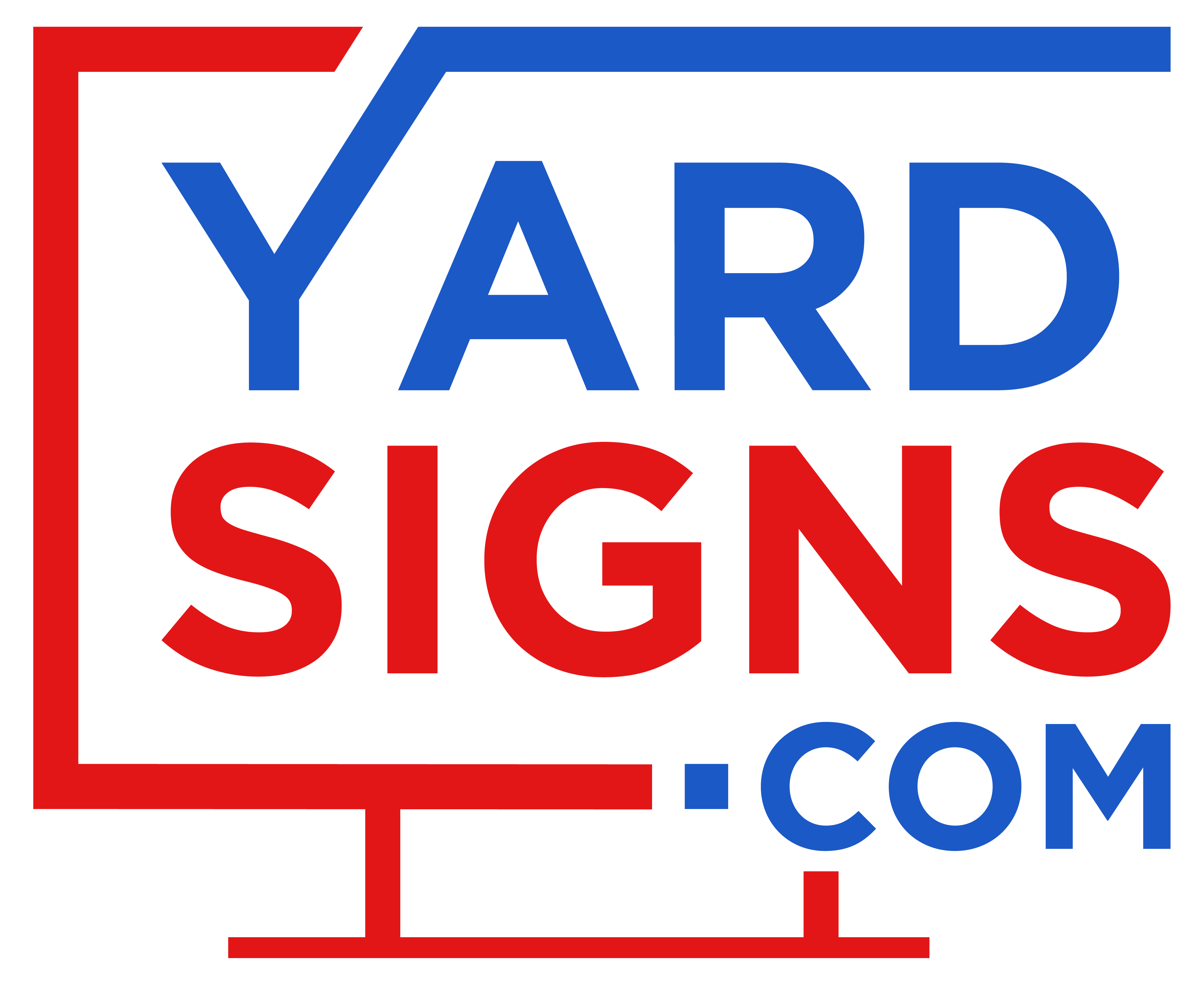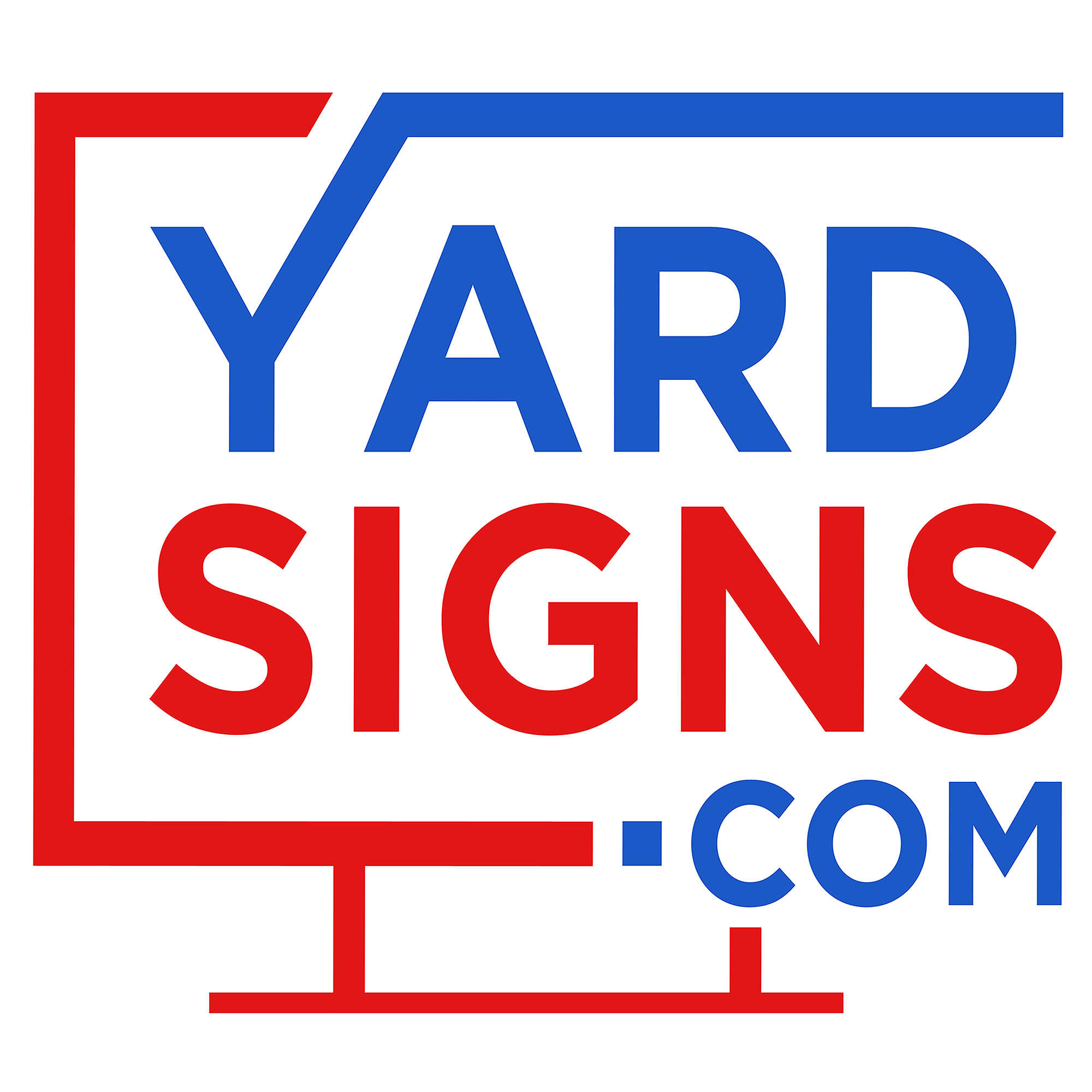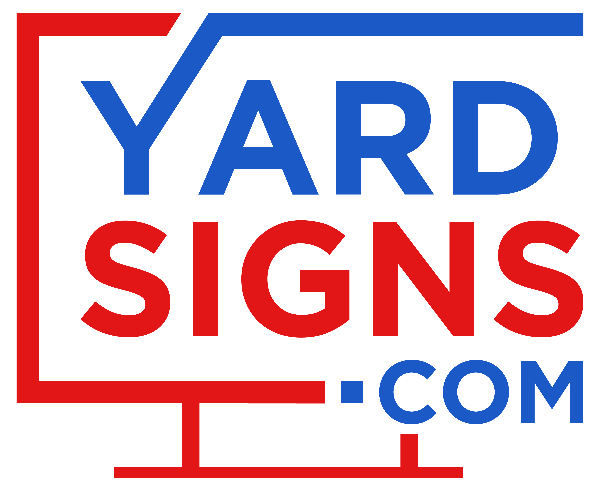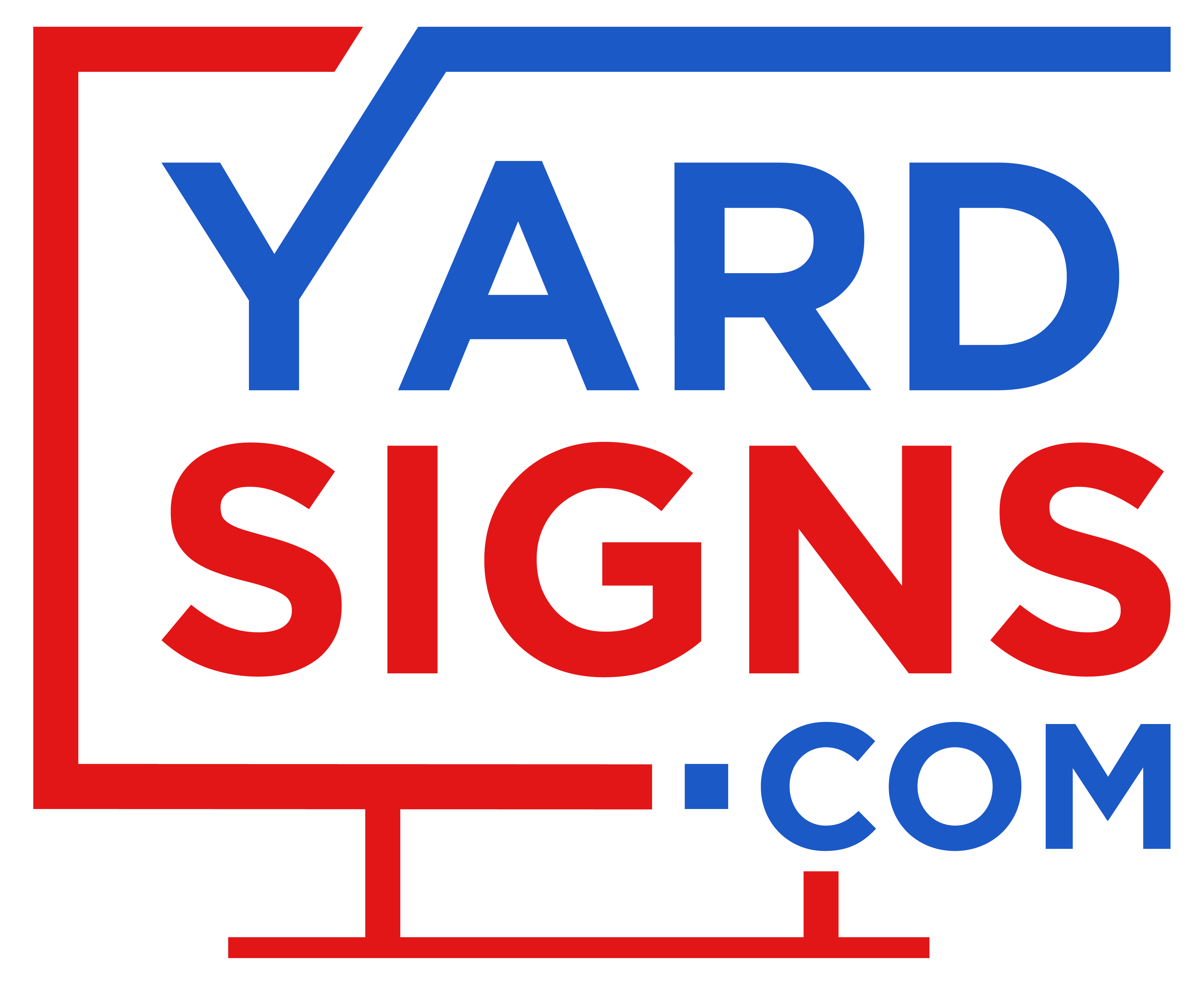Yard signs are lightweight, portable signs typically placed on lawns or along roadsides to communicate messages. These signs appear in front of homes, on business lawns, or along roadways to promote services, advertise events, or provide directions.
The size of a yard sign directly affects how well people can see and understand the message. A sign that's too small might not be readable from the road, while one that's too large might not fit the space or meet local regulations.
This article explains how different yard sign sizes work in various situations, what factors influence size selection, and which dimensions are considered standard in professional settings. You'll learn what size works best for your specific needs and why.
What is the best size for a yard sign?
The standard 24" x 18" yard sign is widely considered the best all-purpose size for most applications. This size offers excellent visibility from passing vehicles while providing enough space for essential information. It works well for real estate listings, political campaigns, business promotions, and community events.

However, the "best" size ultimately depends on several factors:
- Where the sign will be placed
- How fast traffic moves past it
- How much information needs to be displayed
- Local regulations that might restrict sign dimensions
For high-traffic areas where vehicles move quickly, larger 36" x 24" signs provide better visibility. In pedestrian areas or smaller spaces, 18" x 12" signs often work well. The key is matching the sign size to its specific purpose and environment.
Before finalizing your sign dimensions, check local regulations. Many areas restrict the sizes of political and residential signs. Check out our guide on legal yard sign dimensions to ensure compliance.
Key factors that affect yard sign size
Selecting the right yard sign size involves balancing several important considerations. There isn't one perfect size for every situation.
Location and traffic speed
Where you place your sign and how quickly people pass by it directly impact what size works best:
- High-speed roads (35+ mph): Larger signs (36" x 24") are necessary because viewers have less time to read the message.
- Residential streets (under 25 mph): Standard 24" x 18" or smaller 18" x 12" signs work well since viewers have more time to read.
- Pedestrian areas: Smaller signs are effective because people are walking close to the sign.
A sign placed along a highway needs to be much larger than one placed near a sidewalk where people walk by slowly.
Viewing distance
The distance between the viewer and the sign affects how large the letters need to be. A helpful guideline is the 10:1 ratio: each inch of letter height can be read from approximately 10 feet away.
For example:
- Signs viewed from 50 feet need letters at least 5 inches tall
- Signs viewed from 100 feet need letters at least 10 inches tall
This means larger viewing distances require both bigger signs and larger text to maintain readability.
Message length and complexity
The amount of information you need to display directly affects the size required:
- Short messages (name or logo only) can use smaller 18" x 12" signs
- Multiple lines of text, phone numbers, or websites need larger 24" x 18" or 36" x 24" signs
For example, "Vote Smith" fits easily on a small sign, while "Vote Jane Smith for City Council – November 8th" requires more space for the text to remain readable.
Standard yard sign sizes and their best uses
Here's a comparison of common yard sign sizes, their typical applications, and how far away they can be read:
|
Size |
Typical Uses |
Visibility Range |
Best For |
|
12” x 18” |
Directional signs, small yards |
Up to 30 feet |
Tight spaces, supplemental info |
|
18” x 12” |
Event parking, small messages |
Up to 40 feet |
Cost-effective, brief messages |
|
24” x 18” |
Real estate, political, business |
Up to 75 feet |
Most general applications |
|
36” x 24” |
Highways, large properties |
100+ feet |
Maximum visibility, detailed info |
24 x 18 yard signs: The versatile standard
The 24” x 18” size dominates the yard sign industry because it offers the best balance of visibility, content capacity, and ease of installation. This size works well for:
- Real estate listings with agent contact information
- Political campaign messages
- Business promotions with logos and phone numbers
- Community event announcements

This size fits standard wire stakes and metal frames, making installation straightforward. For most applications, 24” x 18” provides the ideal combination of readability and practicality.
18 x 12 yard signs: Compact and cost-effective
The smaller 18” x 12” signs serve specific purposes where space is limited or when the message is brief:
- Directional signs (pointing to open houses or events)
- Parking instructions
- Simple messages like “Thank You” or “Congratulations”
- Supplementary information to larger main signs
These signs cost less to produce and work well when ordered in large quantities. They're perfect for pedestrian areas where viewers are close to the sign.
Larger custom yard signs: Maximum visibility
Signs measuring 36” x 24” or larger serve situations where maximum visibility is essential:
- Rural highways with fast-moving traffic
- Large commercial properties
- Major events needing directional guidance
- Messages with substantial content
These larger signs require sturdier materials and installation methods due to increased wind resistance. They're more expensive but provide significantly better visibility from a distance.
Visual readability and viewing distance
How well people can read your yard sign depends on both its physical size and design elements like font size and color contrast.
Letter height and font choices
The height of your letters directly determines how far away your message can be read:
- For 30-foot visibility: Use minimum 3-inch letters
- For 50-foot visibility: Use minimum 5-inch letters
- For 100-foot visibility: Use minimum 10-inch letters
Simple sans-serif fonts like Arial, Helvetica, or Futura work best for yard signs. These fonts have clean, straight lines that remain legible at a distance. Avoid decorative, script, or overly thin fonts that become difficult to read from afar.

Color contrast and background
The contrast between text and background dramatically affects readability. High-contrast combinations make your message visible from greater distances:
- Black text on yellow background (highest visibility)
- Black text on white background
- White text on blue background
- White text on red background
Avoid low-contrast combinations like yellow on white or light blue on green. Also avoid busy backgrounds or patterns behind text, as these reduce readability significantly.
For maximum readability:
- Use one high-contrast color combination
- Keep the design simple with minimal graphic elements
- Ensure adequate spacing between letters and lines
Choosing materials and frames for professional signs
The materials you select for your yard sign affect its durability, stability, and suitability for different sizes.
Corrugated plastic vs. metal
Two primary materials dominate the yard sign industry:

Corrugated plastic: This lightweight, hollow plastic material (often called Coroplast) is the most common choice for yard signs. It's:
- Affordable and lightweight
- Weather-resistant
- Easy to print on
- Ideal for temporary or seasonal use
- Works well with sizes up to 24” x 18”
Aluminum: Metal signs offer greater durability for long-term or permanent outdoor display. They're:
- More resistant to weather damage
- Less prone to bending or warping
- More expensive than plastic
- Better for larger sizes like 36” x 24”
- Heavier and more difficult to transport
Larger signs create more wind resistance, so stronger materials become more important as sign size increases.
Wire stakes vs. metal frames
How you mount your yard sign depends on its size and intended use:


Wire stakes: These H-shaped or I-shaped metal wires push into the ground and hold the sign in place. They work well for:
- Corrugated plastic signs up to 24” x 18”
- Temporary installations
- Soft ground conditions
- Quick and easy setup
Metal frames: These sturdier structures provide better support for larger or heavier signs. They're ideal for:
- Signs 36” x 24” and larger
- Aluminum signs
- Windy locations
- Long-term installations
The right mounting system ensures your sign remains upright and visible regardless of weather conditions.
Yard sign sizes for different industries
Different industries have developed standard practices for yard sign sizes based on their specific needs.
Real estate and property listings
Real estate professionals typically use 24” x 18” signs because this size:
- Is visible from passing vehicles
- Provides space for agent name, company, and phone number
- Works with standard “rider” signs (6” x 24”) that attach above or below
- Complies with most neighborhood association rules
Real estate signs often use frames rather than stakes for a more professional appearance and better stability during longer listing periods.
Political and campaign signage
Political campaigns use various sizes depending on placement:
- 24” x 18” for most roadside locations
- 18” x 12” for residential yards or areas with size restrictions
- 36” x 24” for high-traffic areas or major intersections
Many municipalities restrict political sign sizes, so campaigns must check local regulations. Signs often use simple messages with the candidate's name and position sought in large, bold letters.
Small businesses and contractors
Service businesses like landscapers, painters, and contractors typically use:
- 24” x 18” signs at job sites
- 18” x 12” signs for smaller spaces or supplemental information
- Consistent branding across all sign sizes
These signs usually display the business name, logo, phone number, and sometimes a brief service description or website address.
Making your message stand out
The best yard sign size balances visibility, message clarity, and practical considerations. While 24” x 18” works well for most situations, your specific needs might call for something different.
Consider these factors when making your final decision:
- Viewing environment: How far away will people be when they see your sign?
- Message complexity: How much information do you need to include?
- Installation location: Where will the sign be placed, and what size fits that space?
- Local regulations: Are there size restrictions in your area?
Regardless of size, focus on clear, high-contrast design with simple messages and adequate letter height for your viewing distance. A well-designed smaller sign often outperforms a poorly designed larger one.
Order your custom yard sign today at Yardsigns.com to ensure your message gets the attention it deserves!
Frequently asked questions about yard sign sizes
What is the most popular yard sign size for real estate?
The 24” x 18” size dominates real estate signage because it offers excellent visibility from passing vehicles while maintaining a professional appearance that homeowners' associations typically accept.
How do local regulations affect yard sign dimensions?
Many municipalities limit yard sign sizes to 24” x 18” or smaller in residential areas, though regulations vary widely by location. Always check local ordinances before ordering signs to ensure compliance.
What size yard sign works best for busy roadways?
For roads with traffic speeds over 35 mph, larger 36” x 24” signs provide better visibility. For residential streets with slower traffic, standard 24” x 18” signs are generally sufficient.
How does weather impact yard sign size selection?
Larger signs face greater wind resistance, so in areas with frequent high winds, either choose smaller dimensions or use sturdier materials and mounting systems for standard and larger sizes.




